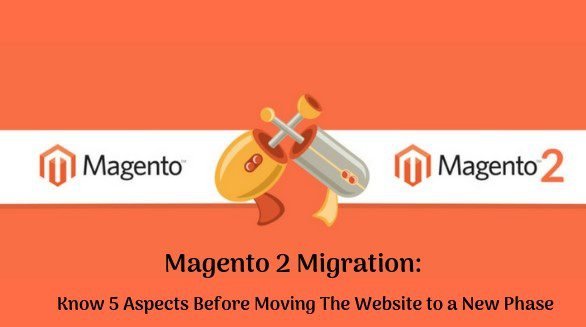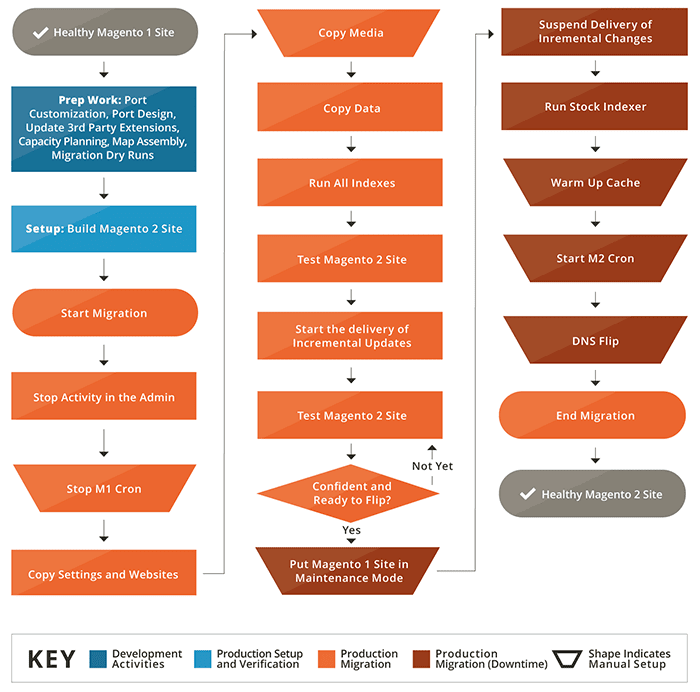
Magento’s mega splash about June 2020 has been the talk of the show for quite a long time. Ever since Magento 2 came in 2015 we all knew the future of Magento 1.
The timeline only gave customers some extra time to deal with the change.
This doesn’t mean one can skip the idea of Magento 2 migration, the end of Magento 1 is .inevitable.
Even with the timeline, we all can see that companies are driving new extensions for Magento 2 compatibility already. So the websites lingering on Magento 1 are missing the opportunity to use those features.
Merchants who are still on Magento 1 need to realize that we have already descended halfway into the year 2019.
Three to six months is a heavy period for migration, which is only for simple e-commerce sites. More complex business units are ought to take some extra time.
Thus, it would be better for all the merchants if they started to migrate Magento 1 to Magento 2 today. Procrastinating the process will only keep your website behind all the potential features.
Instead of discussing the abstract features of Magento 2, here are a few things to consider before taking a plunge into a new platform.
1. Magento 2 is a Box full of features
Technically, Magento 2 came after the first version, so of course, it is going to have rapid and robust features. However, there are a few key takeaways that make the platform quite alluring.
- The new version will provide the websites to function in a fast and efficient manner with decreased delay time.
- The admin-user interface changes to an upgraded level and improvises the back-end management support.
- You are the master of your own customization with reduced cost and efficient timing.
- Various enterprises working on Magento 2 extension have reduced the need for custom, in-built extensions.
Thus, expect your website to run on the above set of features after the successful migration to Magento 2.
2. Checking the Extension Compatibility
While migrating from the old version of Magento you cannot expect every extension and feature to accompany you into Magento.
Certain extensions will take a backseat and may prove to be incompatible.
So, your task is to check all the vital data present under those extensions and preserve it for the new platform.
3. Mark your steps with Data Migration Tool
You are not going to leave behind all your website data on Magento 1, are you?
Fetching data one by one is a task that would take years to complete. So, instead of such manual labor, there comes a data migration tool by the Magento 2 migration services.
The tool brings in robust ways to fit all the necessary data onto the new platform. Thereby, merchants who were concerned about data transfer can rest their worries on this tool.
4. Integration of Media files
The Magento 1 to Magento 2 migration costs both technical and manual expertise. As on one hand, the product can easily make through data migration tools. On the other side, media files require the skill set of your Magento experts.
The media files could be hiding back in the database, file system, front design of the store, and a few more depending on the structure of the website.
Note: The storefront design of Magento 2 is different, so if you want the same layout, you might have to recreate the web design.
5. The state of Extension and Theme Migration
In the previous points, we discussed the data present in the extensions and its compatibility in the forthcoming version.
While there we only saw which extension can or cannot be moved to Magento 2, here you can see tools in action.
Not all extensions might work well with these tools. So, be prepared to recreate the themes and extensions for experiencing a smooth functioning website.
Merchants are future-ready! Now that we know a lot of things about Magento 2, website owners are prepared to face any challenge coming their way.
A concern follows while the websites are at the preparation stage; Is your Magento 1 website safe at this point?
The answer is tricky, so instead will offer you some steps to maintain the security of the Magento 1 store.
- Keep up with all the latest security patches, extensions and themes. Reason? There will be no automatic updates with Magento 2 in the picture.
- It goes without mention that every platform should install with two-factor authentication and certain restrictions of concealing the IP address.
- Change or upgrade your hosting environment. An outdated version is likely to cause security breaches.
Painting the Migration Plan on paper
After all the fury Magento 1 and 2 features, you will need a healthy migration plan, to begin with. We already saw that the process involves the merchants going through a lot of stages.
Here is a compiled chart of all provided by Magento to all its customers.

As you can see the whole process includes a plethora of stages that we just mentioned. However, every penny will be worth the while, with the outbound features of Magento 2.
A few notable changes made in the latest version of Magento are;
- Enhanced UI designing;
- Easy access to Admin Panel;
- Establishment of Omnichannel web experience;
- Efficient and Robust Loading time.
Can you stay back on Magento 1?
The answer is a prompt YES, as nobody is forcing you to re-platform the website. However, in that case, the e-commerce store will be leveraged to many vulnerabilities.
One sole reason is that, with Magento 2 heading the market, the developers at Magento community no longer focus on old security patches and extensions.
So, unless you have a strong firewall to protect the website it’s better to follow Magento 1 to Magento 2 migration steps.
At last, Magento 2 is your ultimate and innovative option to play head-to-head with your competitors. With this platform, you will enter new possibilities for your e-commerce store.
To grab the best side of Magento, leap for the deployment to Magento 2. Later, in June 2020, the migration might not sound as easy as it is today!
Author Bio:

Harshal Shah has countless experiences in the field of Information Technology. Also, he is the CEO of Elsner Technologies Pvt Ltd. Magento development company that offers Magento development services to clients across the globe. Mr. Harshal is a huge tech enthusiastic person who has written major & genuine articles as well as blogs on topics that are relevant to various CMS platforms.
Read Also: HTML to Magento Integration Service




Leave a Reply